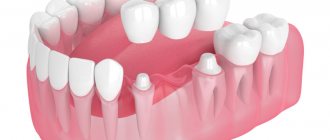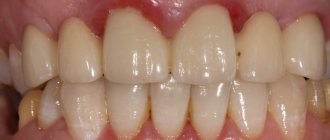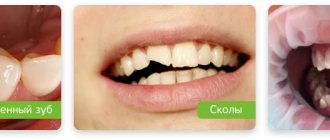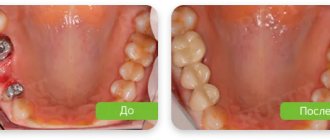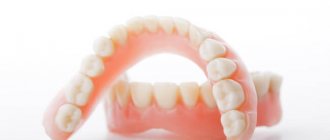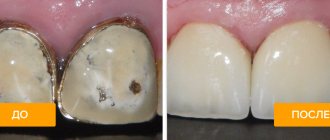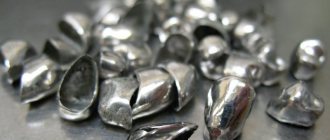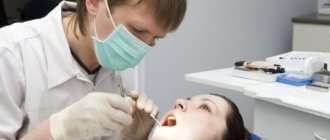Not everyone manages to keep their teeth intact throughout their lives. When teeth are lost, the patient loses the ability to smile beautifully, and he experiences disturbances in speech and chewing functions. Orthopedic dentistry is designed to solve these problems. Restoration of the structure and functions of the masticatory apparatus occurs through the installation of orthopedic structures. Modern designs for prosthetics completely replace lost teeth. They are adaptive, hypoallergenic, and have a long service life.
Indications for installation of a prosthesis
The general indication for prosthetics is damage or absence of a certain number of dental units. Dental defects lead to ineffective chewing of food. The bite is disturbed, the aesthetics of the smile suffers. The most common indications for prosthetics are the following disorders:
- Adentia (complete or partial loss of teeth). Restoration of the dentition is carried out by removable prosthetics or implantation of dental units.
- Complete or partial destruction of the coronal part of the tooth, in which filling is impractical. When preserving the root, a pin structure or stump tab is used.
- Pathological abrasion of enamel, which is a systematic violation of the enamel layer of dental units. The loss of hard dental tissues leads to malocclusion.
- Traumatic damage to teeth. The patient may be offered various options for restoring the dentition, depending on the severity of the situation.
- Pathology of the alveolar process leading to serious malocclusion. A frequent consequence of partial edentia, leading to the restructuring of the alveoli and a decrease in the functionality of the dentition.
- Single and multiple dental defects. The patient can be offered various design options depending on the existing problems.
Types of prostheses
Modern orthodontics offers many types of dental restoration. Each method has its own advantages and disadvantages and is used to solve a particular problem. The type of prosthesis and method of prosthetics are selected by the attending physician together with the patient, based on the clinical situation, budgetary capabilities and patient preferences. Orthopedic structures are distinguished by the method of fixation, the material of manufacture, the defect being replaced, and the type of fastenings in the oral cavity.
Classification by method of fixation
Based on the method of fixation, a distinction is made between removable and non-removable structures. A very special type is fixed dentures on implants.
- Removable structures. They can be removed from the mouth independently. They solve the problem of the absence of one or more units in the dentition. Inexpensive and easy to care for.
- Fixed structures are permanently fixed in the oral cavity. They are durable, strong and efficient. They have a higher cost.
- Implantation is the most complex and expensive type of prosthetics. Implants are a multi-component structure that is inserted into the bone tissue of the jaw and replaces the root part of the teeth. On their basis, the restoration of the dentition is carried out.
Classification by material of manufacture
In modern dentistry, many materials have been developed for the manufacture of prosthetic structures. Here are the four main types:
- Plastic structures are made from polymerized acrylic. This lightweight and durable material is inexpensive and available. The lightweight porous structure ensures a tight fit, which significantly reduces the adaptation time. Under heavy loads, plastic prostheses are prone to loosening and are therefore short-lived. Used for temporary use.
- Nylon prostheses are made from soft, hypoallergenic synthetic material. They are secured in the mouth using special clasps. The disadvantage is its short service life. The chewing load is distributed unevenly, which can lead to bite problems.
- Zirconium dioxide structures. Zirconium dioxide is a durable natural mineral, naturally enriched without the presence of synthetic impurities. Used for the preparation of fixed dentures. It has many advantages: it holds the chewing load well, its shade is close to natural enamel, and it has low thermal conductivity. Zirconium dentures are not used to treat severe malocclusions, since a strong crown begins to destroy neighboring teeth.
- Ceramic dentures are made from specially treated ceramics with the addition of lithium disilicate. The crown material is very durable and reliable, its structure is closest to tooth enamel. Ceramic dentures have the highest aesthetics, therefore they are used for prosthetics in the smile area.
Classification of dentures according to the volume of the replacement defect
Depending on the clinical situation, the patient may be indicated for a complete or partial denture:
- Complete dentures are removable or conditionally removable structures used in the absence of all units in the dentition. A complete denture simulates the entire dentition. The base of the prosthesis rests on the gums and helps fix the structure in the oral cavity.
- Partial dentures help restore dentition when several teeth are missing. They imitate a fragment of the dentition, replacing several nearby missing dental units or teeth lost in different parts of the jaw.
Classification of prostheses by type of fastenings
Depending on the method of fastening the prosthesis in the oral cavity, the functional load on the supporting tissues is distributed differently. The following types of orthopedic structures are distinguished:
- Lamellar dentures are a type of removable structures. Effective for partial or complete edentia. They differ in the material of manufacture and the method of attachment in the oral cavity. Attached directly to the mucous membrane.
- Bridges are non-removable structures used in cases where several dental units are missing in a row. They are attached to dental units spaced apart from each other and ground for crowns.
- Supported or clasp dentures are distinguished by a special way of transferring the load: through the supporting teeth, periodontium and mucous membrane. This method is called semi-physiological.
What problems are encountered during mandibular implantation?
When restoring teeth in the lower jaw, it is necessary to clarify the location of the vessels and the mandibular nerve on it. Before the procedure, a computed tomography scan is required to determine the topography of the nerve and plan the location of the implants so as not to damage it in any way.
The loss of bone tissue in the lower jaw is smaller. For implantation, bone splitting or special thinner implants are often used. Their engraftment is faster than on the top one. And this is the key difference when implanting both jaws.
How to choose the right dentures
The selection of a denture is made by the attending dentist together with the patient. After the initial examination, the doctor assesses the clinical situation and advises the patient, explaining what type of prosthetics is indicated for him. The patient makes a decision taking into account the doctor’s recommendations and his preferences.
Doctors at the Consilium Dent dental clinic will provide a free initial consultation on the selection and installation of orthopedic structures. After the initial examination, the dentist will select the optimal prosthetic option and advise the patient on how to prepare for prosthetics. He will talk in detail about how to care for the oral cavity during and after prosthetics. When choosing, the number of missing teeth, the condition of the tooth bed and gums, financial capabilities and the desire of the patient are taken into account.
Removable dentures. What to prefer?
If all or a significant part of the teeth are lost, the patient will be offered the installation of a removable denture. The removable design is a plastic plate that fits tightly to the mucous membrane and follows its shape. This ensures its strong attachment in the oral cavity. Artificial teeth are attached to the plate, imitating the patient’s own lost dental units. There are two types of removable structures: partially removable and completely removable.
The best partially removable designs
Partially removable dentures are used for partial restoration of the dentition. This type of denture is indicated if only part of the teeth are missing. Plastic and nylon are used for manufacturing. Special hooks or special clasps are used as fastening means. The fasteners are quite strong and provide reliable fixation of the dentition.
Main advantages and disadvantages
Partially removable structures are universal and have many advantages:
- The chewing load is evenly distributed, which ensures the safety of the dentition.
- The oral care procedure is simple and easy.
- Durable clasps provide reliable fixation in the oral cavity.
- The prosthesis ensures complete restoration of chewing function.
- Due to the uniform load, deformation of some dental units is excluded.
Among the disadvantages are the following:
- Dentures are quite expensive.
- Not all designs are sufficiently aesthetic, so they are not suitable for restoration of a row in the smile zone.
- Dentures require periodic adjustments.
Removable structures for complete dentures
This type of structure is used for complete restoration of the dentition in cases of total edentia. These are light and durable dentures that are in good contact with the oral mucosa. Typical denture materials used for complete dentures are nylon or acrylic. The fastenings are made in the form of so-called suction cups.
Advantages and disadvantages
Among the advantages, the following should be noted:
- The designs are easy to manufacture, which determines the low price.
- In case of breakdowns or damage, they can be easily restored.
- Cover a significant part of the sky, which makes contact very reliable
- Easy to care and use.
There are also a number of disadvantages:
- The structures wear out quite quickly, since the work of the masticatory muscles is not always coordinated.
- Due to constant pressure, the volume of tissue in the jaw joint gradually decreases. This impairs the retention of the prosthesis, and it may fall out when speaking.
- If the prosthesis is not positioned correctly, pain may occur in the mouth.
Let us compare the removable structure made of acrylic and nylon.
- Acrylic processes are more affordable.
- Acrylic dentures can break over time, while nylon dentures are made of flexible and durable material, so the likelihood of breakage is minimal.
- An acrylic prosthesis does not deform; a nylon prosthesis can change shape.
- Nylon has a smooth structure, does not absorb odors, does not stain, and is non-toxic. Acrylic is a more porous material and is susceptible to staining and staining over time.
- The color of nylon is closer to the shade of natural enamel and looks aesthetically pleasing. Acrylic has a wide range of shades; it is possible to choose an option that is as close as possible to the individual shade of the teeth.
- Nylon constructions are more hypoallergenic than acrylic ones
Removable dentures without palate
Sandwich dentures are designed for partial prosthetics and are an arch made of dense polymer that imitates the jaw arch. They are fixed to the molars that are preserved on both sides of the jaw. The fasteners are telescopic crowns that fit tightly and fix the product.
The advantage of these designs is that they leave the palate and sublingual space free, which ensures the preservation of diction and the natural sensitivity of taste buds. In some patients, such prostheses cause a gag reflex, which can make wearing difficult. Such patients are recommended to opt for the clasp system.
Careful planning and simulation of the treatment process
At the first stage, the patient must undergo tests and undergo preparation for treatment. It includes a computed tomography scan to evaluate the condition of the maxillary sinus and the quality and volume of the jaw bone.
To restore a segment of chewing teeth using Zygoma implants, multislice computed tomography (MSCT) is performed. It differs from the classic cone-beam in better detail and has higher information content. And this is extremely important for choosing the location for positioning zygomatic implants.
Zygomatic implantation should not be carried out “blindly” - the doctor must clearly understand where elongated implant models can and should be placed so that they are not only securely fixed, but also do not touch the anatomically important structures of the face and jaws (nerves, sinuses). To do this, the Smile-at-Once clinic carries out 3D modeling in modern computer programs (we use Blue Sky Plan, Nobel Clinician or Chairside software).
Our clinic also uses another innovative solution: after virtual modeling of the treatment process, a polymer model of the patient’s lower face (including the jaw system and the zygomatic bone itself) is cast on a 3D printer. On such a model, the installation of analogue implants is once again carried out, but this time not virtual, but real. This allows the doctor to evaluate the course of movement of the implants and their behavior directly in the patient’s bone. That is, it further increases the accuracy of their positioning during the actual implantation procedure.
Expert opinion
Bespalov Roman Dmitrievich Maxillofacial surgeon, implantologist Work experience 25+
“To a patient from the outside it may seem that such implantation is a very simple and quick solution, because all that is required of him is to undergo diagnostics, come to have the implants placed and then get new prostheses. But for a specialist, this means several days of labor-intensive work, careful planning, and choosing the exact location for the implants. In some of the most complex cases, we hold a consultation of doctors in order to avoid mistakes and guarantee our patients the best treatment results.”
Expert advice
There is no clear answer to the question of which prosthesis to choose in a given case. The structural features of the patient’s jaw apparatus, his age, and the severity of the problem are of great importance. Approximate recommendations are given in the table:
| Situation | Type of prosthetics |
| Clinical picture | Recommended type of prosthetics |
| Availability of dental units suitable for fastening the structure | Conditionally removable prosthesis |
| The dentition lacks a large number of dental units, and the installation of bridge-like structures or implantation is impossible | Removable prosthetics |
| Molars or incisors are completely absent from the dentition | Removable prosthetics. It is recommended to choose acrylic dentures |
| Molars and premolars are missing | Partially removable prosthetics |
| Requires installation of temporary prostheses | Partially removable prosthetics |
What crowns are best for chewing teeth?
Single dentures for molars and premolars must first of all solve the problem of functionality and prevent further destruction of hard dental tissues. Aesthetics in this case are secondary. If you need prosthetics, the question immediately arises - which crown is best to put on a chewing tooth? Orthopedic dentistry offers single dentures from different materials:
- metal alloys, including precious ones;
- metal-plastics;
- metal ceramics;
- ceramic composites and their combinations;
- ceramics;
- zirconium dioxide;
- aluminum oxide.
The variety of materials can easily be confusing. When prosthetics of the masticatory region, high demands are placed on crowns in terms of strength and durability. To create a prosthetic structure, biocompatible materials that are resistant to high mechanical load are used.
Fixed dentures. Which ones to choose?
Fixed prosthetic structures are firmly fixed in the patient’s oral cavity with cementing material and are not intended for self-removal. There are three main types of fixed structures: crowns, bridges, microprostheses.
Crowns
A dental crown is a non-removable orthopedic structure of a natural shape that covers the coronal part of a tooth or a separate area of its surface. Crowns are made from high-quality materials: metal, zirconium, porcelain, ceramics, plastic.
Advantages and disadvantages of crowns
The main advantage of dental crowns is that they are able to completely restore the functionality of the dentition. Other benefits include:
- strength;
- aesthetics;
- low price;
- long service life
Among the disadvantages of structures of this type are:
- metal crowns are not aesthetically pleasing enough, so they are not used in the smile area;
- it is not always possible to choose a design color that fully matches the color of natural enamel;
- in some cases it is necessary to sharpen the tooth.
Bridge structures
A bridge is a type of fixed prosthesis used to replace significant defects in the dentition. A bridge rests on two dental units spaced apart from each other and replaces several destroyed, consecutive dental units.
Advantages and disadvantages of bridges
Bridges are structures that are designed for use in cases of significant defects in the dentition. This quality determines the main advantages of the structures:
- When chewing, the load is evenly distributed, determining the long service life of the prosthesis.
- The use of a bridge helps prevent atrophic processes in bone tissue. They begin due to insufficient load on the jaw in the absence of a significant number of dental units.
- A bridge can ensure normal grinding of food during chewing, and therefore maintain the health of the patient’s digestive system.
The disadvantages of bridges include the following:
- A structure that replaces several dental units is quite expensive.
- Teeth that serve as support have to be ground down and depulped even if they are healthy.
Microprostheses
Microprostheses are microstructures made of ceramic or composite material that serve to restore the damaged part of the tooth surface. These include dental inlays, veneers and lumineers.
Microprosthetics is a gentle technology designed to preserve severely damaged teeth. It allows you to protect the front wall of the tooth and restore the aesthetics of the dentition.
Advantages and disadvantages of microprostheses
The advantages of microprosthetics are obvious:
- A microprosthesis effectively hides defects and strengthens the tooth, which prevents its further destruction.
- An ideally selected shade makes the tooth indistinguishable from other units of the dentition.
- Microprosthetics does not require grinding of teeth.
The disadvantages are:
- Microprosthetics cannot be used for carious teeth.
- The cost of the procedure is quite high.
When choosing the appropriate type of prosthetics, the dentist aims to solve the patient’s problem in the most acceptable way.
| Situation | Type of prosthetics |
| One or more incisors are destroyed | Dental crown made of ceramics |
| Completely missing dental unit | Bridge prosthesis |
| Chipped edges of the tooth | Microprosthetics (veneers) |
| Chewing teeth destroyed | Dental crown. Recommended materials: metal, metal ceramics |
Disadvantages of the method
Zygomatic implantation, no matter how many implants are used to restore teeth, places the highest demands on the experience and professionalism of doctors.
We not only practice, but also teach others!
Smile-at-Once is an immediate loading implantation university in Russia. We are the only ones who know and apply all methods, and not just one.
More details
“You can only trust zygomatic implantation to implant surgeons with extensive experience, and even better – to maxillofacial surgeons. We can say that the protocol using zygomatic implants is the gold standard of implantology in general, since it allows for the rehabilitation of those patients who, 7-10 years ago, were doomed to a toothless life and were content exclusively with removable dentures. And it’s not just about the complexity of installing zygomatic implants, but about compliance with all the requirements of the protocol, careful study of the entire process, and verification of every detail. With any approach, 90% of success depends on the doctor, and when performing zygomatic implantation, this figure reaches almost 100%,” adds Vladimir Anatolyevich Put.
Another disadvantage of the protocol is its higher price compared to alternatives. But on the other hand, there are also wider opportunities in terms of using the technique in conditions of very extreme bone tissue atrophy.
Which prosthesis to choose: removable or fixed?
Knowledge of the advantages and disadvantages of removable and fixed structures will help you choose the optimal type of prosthetics
| Kinds | Advantages | Advantages |
| Fixed structures | High level of reliability | There is a need to grind down adjacent teeth |
| Quick adaptation to the prosthesis and comfortable wearing | Sometimes the mucous membrane rubs when worn, making correction difficult | |
| High aesthetics | While the process of adaptation is underway, changes in diction and taste of food may be observed. | |
| The chewing load is distributed evenly | High cost with good quality material | |
| Easy to care for | When installing metal crowns, a metallic taste in the mouth is possible. | |
| With proper care, a long service life will be ensured. | ||
| Removable structures | Maintenance is simple and easy | Over time, the denture may become dislodged when eating. |
| Low cost | There is a risk of developing stomatitis | |
| The installation procedure is short | In some cases it is necessary to use a fixing paste | |
| Periodontal disease is not an obstacle to installing a prosthesis | When worn, a gag reflex may occur | |
| This type of prosthesis can be manufactured quickly | When worn, the shape of the face may change |
The choice of the type of prosthesis for each patient occurs individually. Dentists recommend paying attention to removable structures for the following problems:
- with complete or partial edentia;
- if there are pathological changes in the periodontium;
- if oral care is not thorough enough;
- if there are terminal defects of the dentition.
- in case of financial difficulties.
Fixed dentures are recommended for choice in the following cases:
- when no more than one or two units are missing in the dentition;
- if there are significant chips in the enamel;
- with pathological abrasion of enamel;
- with yellowed enamel;
- if it is necessary to restore the smile area;
- in the presence of carious teeth.
Popular questions about prosthetics
Here are collected popular questions from patients about prosthetics asked on the site forum. Experienced dentists answer.
Which prosthesis to choose: plastic or silicone?
Silicone has a short period of adaptation, is comfortable to wear, and does not rub the gums. Disadvantage of silicone: caring for them is more difficult.
Which type of prosthesis is better: a bridge structure or a suction cup prosthesis?
If there is a problem of missing several dental units in a row, the optimal choice would be a bridge. It will ensure uniform distribution of the load on the jaw, will serve for a long time, and is comfortable to use.
Which prosthesis to choose: plastic or nylon?
It all depends on which dental units need dentures. For chewing teeth, acrylic plastic is more suitable as the most durable and comfortable material to wear. Nylon dentures are suitable for premolars and incisors.
Which prosthesis design should I choose from plate-type prostheses?
If a temporary prosthesis is needed, then a removable plate structure is chosen. A fixed prosthesis is chosen in the absence of at least three dental units in a row in the dentition.
Which denture should a person prone to allergies choose: acrylic or nylon?
Nylon has more hypoallergenic properties. In addition, a nylon prosthesis is more flexible and less likely to rub the oral mucosa.
How does bone grafting proceed in the lateral parts of the jaw?
The sinus lift procedure on the upper jaw, according to our observations, is required in 80-90% of cases. In most cases, we use a protocol in which sinus lift is performed simultaneously with implantation. This allows you to reduce treatment time.
Sinus lift surgery can be closed or open. The closed type is more gentle and is easier to tolerate by the body.
When creating a bed for an implant, the mucous membrane of the maxillary sinus is lifted with a special tool and a limited amount of biomass is placed into the resulting cavity. Then implantation is performed. The implant takes root as the bone matures. The process takes 5-6 months.
Open sinus lift takes longer. A “window” is cut into the maxillary sinus from the side of the jaw, and then an osteoplastic mass is placed into the cavity, the hole is closed with a bioresorbable membrane and sutured with a gum flap. The engraftment period is 6-7 months.
In the lower jaw, bone grafting is performed using other methods. This is due to the predominant decrease not in the height of the bone, but in the width. To get rid of this deficiency, most often the bone is split and a non-load-bearing implant is implanted. The implantologist will be able to tell you after diagnosis which method of bone grafting is suitable in your case, and whether this procedure can be avoided and teeth implanted in one visit. Come for a consultation!
